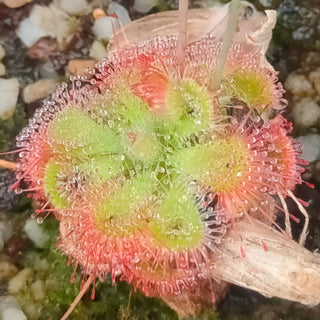Lophophora fricii x koehresii
PEYOTE CACTUS
- Unit price
- / per
This Peyote can be shipped to both the USA and Canada!
Lophophora fricii has a very limited range in Northern Mexico. It is found growing on plains with xerophyllous scrub, mesquite and agave, and on limestone slopes and mountain tops. Illegal collecting for producing ointments poses a threat to this species.
Lophaphora koehresii has big pale pink flowers and unusually thin petals. It is a globular spineless like the other Lophophora members with a large tap root. In cultivation, once a mature plant reaches 5-6 centimetres in width, pups begin to grow.
Type: Perennial
Hardiness zone: 10-11
Location: Sun
Caution poison: Ornamental use only. Hallucination, agitation, tachycardia, mydriasis, hypertension and vomiting. Most poisoning occurred after ingestion of the plant or its decoction.
Fill small pots with a 50:50 compost and sand mix, and soak the compost using boiling water to kill parasites. Allow to drain and cool for about an hour. Sprinkle seeds evenly over the compost mix. Cover the pots with plastic, or place in a clear ziplock bag. Place in a well lit window but not in direct sunlight. Temperature should reach above 80F (26C) to 110F (43C) during the day, and must dip below 80F at night for best germination results. If seed trays begin to dry out, spray to moisten the surface. Seeds should germinate within 4 to 20 days. When seedlings are about four months old begin acclimatizing by opening the bag to reduce moisture. Keep seedlings in indirect sunlight for about six months. The plants should have a lush green color. If they appear to turn red it means they are getting too much light.
Lophophora fricii x koehresii
PEYOTE CACTUS
- Unit price
- / per
Multiple secure payment options available.
Adding product to your cart
You may also like
This Peyote can be shipped to both the USA and Canada!
Lophophora fricii has a very limited range in Northern Mexico. It is found growing on plains with xerophyllous scrub, mesquite and agave, and on limestone slopes and mountain tops. Illegal collecting for producing ointments poses a threat to this species.
Lophaphora koehresii has big pale pink flowers and unusually thin petals. It is a globular spineless like the other Lophophora members with a large tap root. In cultivation, once a mature plant reaches 5-6 centimetres in width, pups begin to grow.
Type: Perennial
Hardiness zone: 10-11
Location: Sun
Caution poison: Ornamental use only. Hallucination, agitation, tachycardia, mydriasis, hypertension and vomiting. Most poisoning occurred after ingestion of the plant or its decoction.
Fill small pots with a 50:50 compost and sand mix, and soak the compost using boiling water to kill parasites. Allow to drain and cool for about an hour. Sprinkle seeds evenly over the compost mix. Cover the pots with plastic, or place in a clear ziplock bag. Place in a well lit window but not in direct sunlight. Temperature should reach above 80F (26C) to 110F (43C) during the day, and must dip below 80F at night for best germination results. If seed trays begin to dry out, spray to moisten the surface. Seeds should germinate within 4 to 20 days. When seedlings are about four months old begin acclimatizing by opening the bag to reduce moisture. Keep seedlings in indirect sunlight for about six months. The plants should have a lush green color. If they appear to turn red it means they are getting too much light.


















































